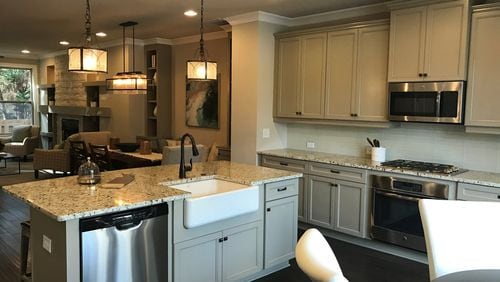Buyers checking out the metro area’s latest new-home developments may have noticed a kitchen trend: A hot option is starting to edge out the usual stainless, double-bowl sinks.
“Just about everyone who walks in says they want a farmhouse sink,” said Angi Sago, design manager for Traton Homes that builds single-family and townhouse plans across the city’s northside. “Then they ask if I’ve seen the show ‘Fixer Upper.’”
Anyone who has watched the makeover program, hosted by remodelers Chip and Joanna Gaines, knows that the couple is crazy for farmhouse sinks, those deep, rectangular designs that can be ordered in porcelain, enameled cast iron and, now, stainless steel. Television influences notwithstanding, buyers are also opting for the farmhouse style because they like the look of the single bowl that isn’t surrounded by cabinetry.
“It has nothing to do with practicality or farmhouses, even,” said Sago. “People just love the look of it.”
Despite what buyers and renovating homeowners might want, the price of a farmhouse sink often sends them back to looking at stainless steel. At Traton, this sink is an upgrade that adds at least $1,200 to the cost of the kitchen.
New homes being built in 17 communities around the metro area by the Providence Group offer the upgrade for about $1,500. Buyers will find that option at East of Main and Chelsea Walk in Alpharetta, Traditions in Cumming and Bellmoore Park in Johns Creek.
“Everybody wants a farmhouse sink, but due to the price, some end up with the standard, under-mounted stainless steel,” said Staci Taylor, the company’s design manager. “The price does depend on the whether it’s cast iron, porcelain or stainless, but it does include charges to cut the cabinet to fit in the sink. And it’s important to point out that they can’t easily be added later — that would require altering the cabinetry and the plumbing, since farmhouse sinks sit lower, so it’s easier to install one in the construction phase.”
Taylor offers buyers different sizes of farmhouse sinks, including ones that are split in half or 60/40 with a low divider. The choice often comes down to an aesthetic preference.
“Some want it for that single-bowl look; others just like the look of the upgrade,” she said. “There’s also the consideration that cast iron is not supposed to chip or stain, whereas porcelain or stainless can scratch. Also, we’re seeing more people who want to get away from that idea that everything in the kitchen has to be matchy-matchy. A sink has become just another accessory they can mix in to the overall look.”
While the most common farmhouse styles are in shades of white, the popularity of the sink has spawned a variety of color options.
“For some time, we were just doing white and off-white, but now we’re seeing lots of colors,” said Sago. “Kohler has a sea salt with white and cream flecks that’s stunning with granite. Of course, that’s another upgrade, and when you start getting into fancy colors, you’re adding $2,000 to $2,500.”
Another farmhouse option comes in stainless steel, a style particularly big with young buyers, said Sago. “It’s just a little more contemporary.”
Even before they know the style comes in stainless, Sago says a farmhouse sink is one of the first things buyers ask about.
“It’s definitely become the Chip-and-Joanna sink,” she said with a laugh. “Buyers want what they’ve seen on TV.”
About the Author






